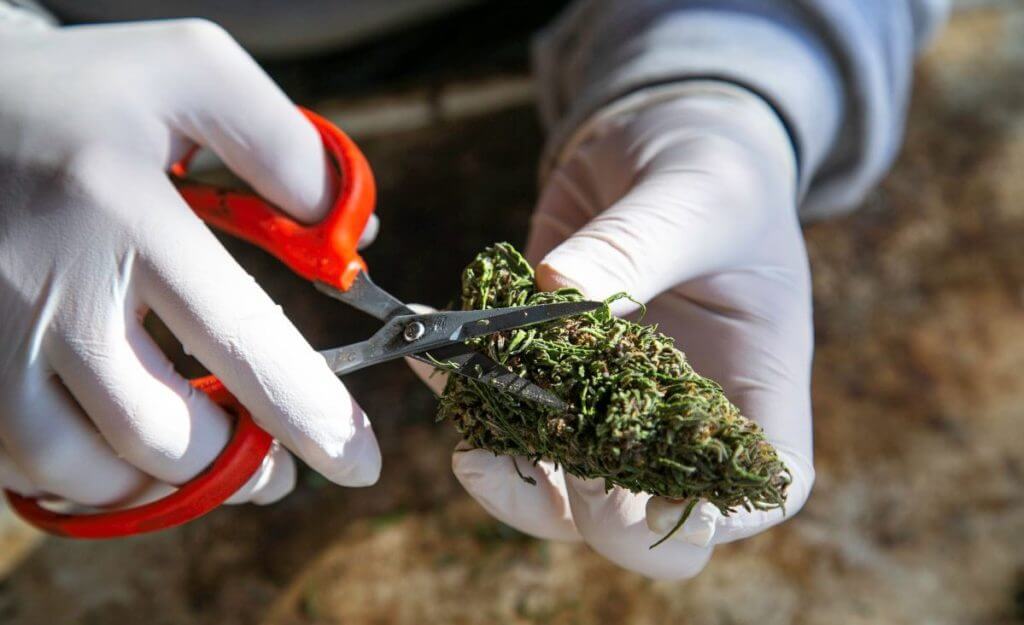
A woman who collapsed and died after an asthma attack in an indoor marijuana cultivation facility is the first-known allergy-related death in the cannabis industry. The woman was an employee at a licensed facility where marijuana plants are grown and harvested.
The death of Lorna McMurrey of Springfield, Massachusetts raises concerns about the asthma and allergy risks for cannabis workers. There are more than 400,000 such workers in the U.S., and that’s projected to grow as more states legalize marijuana for recreational use.
Allergists and occupational health experts say that workers who handle marijuana plants or breathe in cannabis “dust” can become sensitized to cannabis allergens, leading to reactions. Another risk: breathing in mold and fungi that grow on the plants.
Symptoms of an allergic reaction to cannabis can include congestion and runny nose, and hives or skin swelling. But inhaling cannabis allergens can also trigger asthma symptoms, including coughing, wheezing and shortness of breath.
Anyone can develop occupational asthma after exposure to an allergen on the job. However, those with pre-existing allergies and asthma may be at higher risk, says Mike Van Dyke, PhD, an associate professor in the Department of Environmental and Occupational Health at University of Colorado.
“What we really worry about is anybody who has a high degree of allergies and asthma. Those are generally going to be the people at highest risk,” Van Dyke says.
Cannabis Worker’s Death: What Happened?
McMurrey, 27, was grinding flowers to fill marijuana cigarettes at a cannabis facility owned by Trulieve in Holyoke, Massachusetts, on January 4, 2022. She began having breathing difficulty and collapsed. Federal investigators concluded she died from occupational asthma due to exposure to ground cannabis.
“The employee could not breathe and was killed, due to the hazards of ground cannabis dust,” said the report from the federal Occupational Safety and Health Administration (OSHA).
News of McMurrey’s death was first reported in October 2022 on The Young Jurks, a cannabis podcast. Her mother, Laura Bruneau, told the host her daughter texted that morning, saying she was having trouble “walking and breathing.”
Bruneau also spoke to NBC 10 Boston. She said her daughter was taken by ambulance to the hospital, and remained on life support for four days before her death. “I lost my whole world,” Bruneau said.
McMurrey’s death certificate says she died due to cardiac and respiratory arrest from a presumed severe asthma attack.
OSHA fined Trulieve $35,000, citing violations to the Occupational Safety and Health Act. In a letter to the company, OSHA area director Mary Hoye stated that employees weren’t given enough training on the hazards involved with cannabis production and grinding. Nor were they taught about exposure prevention, signs of allergic reactions, or the need for medical help if they experienced symptoms. The company is contesting the penalties.
Cannabis Facilities and Allergens
Reports of wheezing and other breathing difficulties in cannabis facilities go back more than a decade, says Van Dyke. He co-authored a safety guide for cannabis workers published by the Colorado Department of Public Health & Environment. “We recognized fairly early on there is a potential for lots of respiratory exposures,” he says.
Researchers have identified several allergens in Cannabis sativa, the plant better known as marijuana. The most common is Can s 3, a protein found in the leaves, buds, flowers and seeds.
When working inside a facility, handling the plant may lead to sensitization, says Ajay Nayak, PhD, a research scientist and immunologist at Thomas Jefferson University in Philadelphia. So can breathing in fine particles of plant material. These particles are kicked up into the air where cannabis is harvested and processed.
Also of interest to researchers: the cannabis plant also has some unique characteristics, that have the potential to impact both the immune system and allergy, he adds.
Cannabis contains over 100 cannabinoids, or chemical compounds, some of which have been shown to induce immune system changes. These include THC as well as CBD, which research suggests may have anti-inflammatory effects. Terpenes, which give the plant its aroma, are another naturally occurring chemical in cannabis that may alter immune system response.
“Cannabis has a very rich chemical profile,” he says. “Both cannabinoids and terpenes can be immunomodulatory .… But how do they change the immune response, and is this contributing to allergy, we don’t yet know.”
Mold or fungi spores in the air can also be potent allergens. They can trigger symptoms from itchy eyes and a runny nose to breathing problems. “You are growing something in an enclosed environment. Anytime you have water and organic material, you are going to have mold,” Van Dyke says.
What Are the Risks to Consumers?
The Young Jurks’ host, Mike Crawford, says he’s received numerous complaints from workers at various marijuana cultivation facilities. They say they’re worried about breathing problems and mold in their workplaces.
“When I talk to the employees, they are telling me they’re coming down with asthma and COPD,” Crawford says.
There have also been plenty of cases of people who use cannabis for medical or recreational purposes becoming sensitized to cannabis allergens. Sensitization can occur through smoking cannabis, being exposed to secondhand cannabis smoke, or by consuming products containing cannabis, allergists say.
Although not common, cannabis can lead to serious anaphylactic reactions. Most such cases are attributed to consuming hemp seeds, which are sometimes added to smoothies and other health foods.
Protecting Cannabis Workers
To help protect workers, Van Dyke recommends that grow facilities be required to have respiratory surveillance programs. These have been used in other industries to monitor workers’ lungs for signs of problems or declining function.
“A respiratory surveillance program is an important piece of this,” he says. “This death clearly underscores the need. So many times, it takes something horrible happening for things to change.”
Wearing a respirator while handling or processing the plants, along with gloves, a gown and eye protection, may help limit exposures, the experts note.
Nayak recommends that cannabis facility employees who have asthma make sure their condition is well-controlled. If they notice any allergy symptoms or breathing issues, at a minimum, ask to switch to a job with less exposure to the plants. Also, go see your doctor or an allergist.
“If you have never been asthmatic and you start wheezing and having other symptoms, it’s important to get it checked,” he says.
Related Reading:
Marijuana Allergy: From Symptoms to Causes and Cross-Reactions
Risks of Airborne Reactions with Nuts in Industrial Settings





